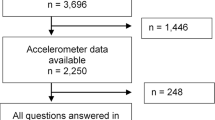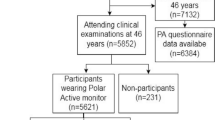Abstract
The combined effects of physical activity (PA) and sitting time (ST) on physical functioning (PF) may be stronger than for each factor separately. This study examined associations between ST, PA, and PF over 6 years in older women. Data were from 6,611 participants in the Australian Longitudinal Study on Women’s Health (mean age 78 ± 1.5 years). Activity pattern at baseline (2002) was categorized as one of 12 combinations of ST (<4, 4–7, or ≥8 h/day) and PA (<40, 40–450, 450–900, or ≥900 MET min/week). PF was measured using the SF-36 (range 0–100) in 2002, 2005, and 2008. General estimating equations for linear regression were used with adjustment for confounders. Baseline PF ranged from 40 to 74 in the least to the most active groups. PF was 6.3 (95 % confidence interval [CI] −7.6 to −5.0) points lower in participants sitting ≥8 h/day than in participants sitting <4 h/day, and 16.9 (CI 15.7–18.0) points higher in participants reporting ≥900 MET min/week than in participants reporting <40 MET min/week PA. Compared with the least active pattern, those in the most active pattern scored 24.5 (CI 22.5–26.4) points higher. The decline over 6 years was greater in the more active categories: 5 and 16 points in the least and most active categories. In conclusion, in women, both high physical activity and low sitting time are important for establishing a certain level of PF prior to age 76–81, but do not protect against decline in PF over time later in life. The combined effect of ST and PA did not differ from their individual effects on PF.


Similar content being viewed by others
References
Aiken LS, West SG (1991) Multiple regression: testing and interpretig interactions. Sage, Newbury Park, CA
Ainsworth BE, Haskell WL, Herrmann SD, Meckes N, Bassett DR, Jr, Tudor-Locke C, Greer JL, Vezina J, Whitt-Glover MC, Leon AS (2011) 2011 Compendium of physical activities: a second update of codes and MET values. Med Sci Sports Exerc. doi:10.1249/MSS.0b013e31821ece12
Bohannon RW, DePasquale L (2010) Physical functioning scale of the short-form (SF) 36: internal consistency and validity with older adults. J Geriatr Phys Ther 33(1):16–18
Booth FW, Laye MJ, Roberts MD (2011) Lifetime sedentary living accelerates some aspects of secondary aging. J Appl Physiol 111(5):1497–1504. doi:10.1152/japplphysiol.00420.2011
Brown WJ, Bryson L, Byles JE, Dobson AJ, Lee C, Mishra G, Schofield M (1998) Women’s Health Australia: recruitment for a national longitudinal cohort study. Women Health 28(1):23–40
Brown WJ, Burton NW, Marshall AL, Miller YD (2008) Reliability and validity of a modified self-administered version of the Active Australia physical activity survey in a sample of mid-age women. Aust N Z J Public Health 32(6):535–541. doi:10.1111/j.1753-6405.2008.00305.x
Chen X, Ender P, Mitchell M, Wells C (2003) Stata Web Books, Regression with Stata. UCLA: Academic Technology Services—Statistical Consulting Group. http://www.ats.ucla.edu/stat/stata/webbooks/reg/chapter2/statareg2.htm. Accessed Sept 2012
Cooper R, Mishra GD, Kuh D (2011) Physical activity across adulthood and physical performance in midlife: findings from a British birth cohort. Am J Prev Med 41(4):376–384. doi:10.1016/j.amepre.2011.06.035
DiPietro L (2001) Physical activity in aging: changes in patterns and their relationship to health and function. J Gerontol A Biol Sci Med Sci 56(2):13–22
Dunstan DW, Howard B, Healy GN, Owen N (2012) Too much sitting: a health hazard. Diabetes Res Clin Pract 97(3):368–376. doi:10.1016/j.diabres.2012.05.020
Gill TM, Allore H, Guo Z (2003) Restricted activity and functional decline among community-living older persons. Arch Intern Med 163(11):1317–1322. doi:10.1001/archinte.163.11.1317
Goldberg D, Bridges K, Duncan-Jones P, Grayson D (1988) Detecting anxiety and depression in general medical settings. BMJ 297(6653):897–899
Gregg EW, Cauley JA, Seeley DG, Ensrud KE, Bauer DC (1998) Physical activity and osteoporotic fracture risk in older women. Study of Osteoporotic Fractures Research Group. Ann Intern Med 129(2):81–88
Harris TJ, Owen CG, Victor CR, Adams R, Cook DG (2009) What factors are associated with physical activity in older people, assessed objectively by accelerometry? Br J Sports Med 43(6):442–450. doi:10.1136/bjsm.2008.048033
Haskell WL, Lee IM, Pate RR, Powell KE, Blair SN, Franklin BA, Macera CA, Heath GW, Thompson PD, Bauman A (2007) Physical activity and public health: updated recommendation for adults from the American College of Sports Medicine and the American Heart Association. Med Sci Sports Exerc 39(8):1423–1434. doi:10.1249/mss.0b013e3180616b27
Hillsdon MM, Brunner EJ, Guralnik JM, Marmot MG (2005) Prospective study of physical activity and physical function in early old age. Am J Prev Med 28(3):245–250. doi:10.1016/j.amepre.2004.12.008
Kanis JA, Johnell O, Oden A, De Laet C, Mellstrom D (2004) Epidemiology of osteoporosis and fracture in men. Calcif Tissue Int 75(2):90–99. doi:10.1007/s00223-004-0287-6
Kaplan MS, Newsom JT, McFarland BH, Lu L (2001) Demographic and psychosocial correlates of physical activity in late life. Am J Prev Med 21(4):306–312
Knol MJ, Egger M, Scott P, Geerlings MI, Vandenbroucke JP (2009) When one depends on the other: reporting of interaction in case–control and cohort studies. Epidemiology 20(2):161–166. doi:10.1097/EDE.0b013e31818f6651
Landi F, Onder G, Carpenter I, Cesari M, Soldato M, Bernabei R (2007) Physical activity prevented functional decline among frail community-living elderly subjects in an international observational study. J Clin Epidemiol 60(5):518–524. doi:10.1016/j.jclinepi.2006.09.010
Lee C, Dobson AJ, Brown WJ, Bryson L, Byles J, Warner-Smith P, Young AF (2005) Cohort profile: the Australian longitudinal study on women’s health. Int J Epidemiol 34(5):987–991. doi:10.1093/ije/dyi098
Matthews CE, George SM, Moore SC, Bowles HR, Blair A, Park Y, Troiano RP, Hollenbeck A, Schatzkin A (2012) Amount of time spent in sedentary behaviors and cause-specific mortality in US adults. Am J Clin Nutr 95(2):437–445. doi:10.3945/ajcn.111.019620
Patel AV, Bernstein L, Deka A, Feigelson HS, Campbell PT, Gapstur SM, Colditz GA, Thun MJ (2010) Leisure time spent sitting in relation to total mortality in a prospective cohort of US adults. Am J Epidemiol 172(4):419–429. doi:10.1093/aje/kwq155
Pavey TG, Peeters GG, Brown WJ (2012) Sitting-time and 9-year all-cause mortality in older women. Br J Sports Med. doi:10.1136/bjsports-2012-091676
Peel NM, McClure RJ, Bartlett HP (2005) Behavioral determinants of healthy aging. Am J Prev Med 28(3):298–304. doi:10.1016/j.amepre.2004.12.002
Peeters G, Page A, Koster A, Matthews CE, Dobson AJ, Brown WJ (2013) Accounting for Physical Activity in Sedentary Behaviour Research: a theoretical framework. 3rd International Conference on Ambulatory Monitoring of Physical Activity and Movement. University of Massachusetts, Amherst, MA
Rantanen T, Guralnik JM, Sakari-Rantala R, Leveille S, Simonsick EM, Ling S, Fried LP (1999) Disability, physical activity, and muscle strength in older women: the Women’s Health and Aging Study. Arch Phys Med Rehabil 80(2):130–135
Rasinaho M, Hirvensalo M, Leinonen R, Lintunen T, Rantanen T (2007) Motives for and barriers to physical activity among older adults with mobility limitations. J Aging Phys Act 15(1):90–102
Rosenberg DE, Bull FC, Marshall AL, Sallis JF, Bauman AE (2008) Assessment of sedentary behavior with the International Physical Activity Questionnaire. J Phys Act Health 5(Suppl 1):S30–S44
Rothman KJ, Greenland S, Walker AM (1980) Concepts of interaction. Am J Epidemiol 112(4):467–470
Santos DA, Silva AM, Baptista F, Santos R, Vale S, Mota J, Sardinha LB (2012) Sedentary behavior and physical activity are independently related to functional fitness in older adults. Exp Gerontol. doi:10.1016/j.exger.2012.07.011
Stel VS, Pluijm SM, Deeg DJ, Smit JH, Bouter LM, Lips P (2004) Functional limitations and poor physical performance as independent risk factors for self-reported fractures in older persons. Osteoporos Int 15(9):742–750. doi:10.1007/s00198-004-1604-7
Tager IB, Haight T, Sternfeld B, Yu Z, van Der Laan M (2004) Effects of physical activity and body composition on functional limitation in the elderly: application of the marginal structural model. Epidemiology 15(4):479–493
Thorp AA, Owen N, Neuhaus M, Dunstan DW (2011) Sedentary behaviors and subsequent health outcomes in adults a systematic review of longitudinal studies, 1996–2011. Am J Prev Med 41(2):207–215. doi:10.1016/j.amepre.2011.05.004
US Department of Health and Human Services (2008) 2008 Physical activity guidelines for Americans: be active, healthy, and happy! US Department of Health and Human Services. http://www.health.gov/paguidelines/pdf/paguide.pdf
van der Ploeg HP, Chey T, Korda RJ, Banks E, Bauman A (2012) Sitting time and all-cause mortality risk in 222 497 Australian adults. Arch Intern Med 172(6):494–500. doi:10.1001/archinternmed.2011.2174
van Uffelen JG, Watson MJ, Dobson AJ, Brown WJ (2010) Sitting time is associated with weight, but not with weight gain in mid-aged Australian women. Obesity (Silver Spring) 18(9):1788–1794. doi:10.1038/oby.2009.511
Visser M, Pluijm SM, Stel VS, Bosscher RJ, Deeg DJ, Longitudinal Aging Study A (2002) Physical activity as a determinant of change in mobility performance: the Longitudinal Aging Study Amsterdam. J Am Geriatr Soc 50(11):1774–1781
Visser M, Goodpaster BH, Kritchevsky SB, Newman AB, Nevitt M, Rubin SM, Simonsick EM, Harris TB (2005) Muscle mass, muscle strength, and muscle fat infiltration as predictors of incident mobility limitations in well-functioning older persons. J Gerontol A Biol Sci Med Sci 60(3):324–333. doi:http://www.ncbi.nlm.nih.gov/pubmed/15860469
Ware JE Jr, Sherbourne CD (1992) The MOS 36-item short-form health survey (SF-36). I. Conceptual framework and item selection. Med Care 30(6):473–483
Wijlhuizen GJ, de Jong R, Hopman-Rock M (2007) Older persons afraid of falling reduce physical activity to prevent outdoor falls. Prev Med 44(3):260–264. doi:10.1016/j.ypmed.2006.11.003
Acknowledgments
The research on which this paper is based was conducted as part of the Australian Longitudinal Study on Women’s Health, The University of Newcastle and The University of Queensland. We are grateful to the Australian Government Department of Health and Ageing for funding and to the women who provided the survey data. GP was supported by a Australian National Health and Medical Research Council program grant (Grant No. 569940: Owen, Bauman and Brown) and the Australian National Health and Medical Research Council Centre of Research Excellence (Grant No. APP1000986). The funding sources had no involvement in the study design, data collection, analyses and interpretation, or writing of the manuscript.
Author information
Authors and Affiliations
Corresponding author
Additional information
Responsible Editor: D. J. H. Deeg.
Rights and permissions
About this article
Cite this article
Peeters, G., Lips, P. & Brown, W.J. Changes in physical functioning over 6 years in older women: effects of sitting time and physical activity. Eur J Ageing 11, 205–212 (2014). https://doi.org/10.1007/s10433-013-0300-x
Published:
Issue Date:
DOI: https://doi.org/10.1007/s10433-013-0300-x




